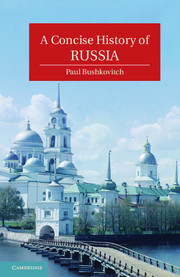Book contents
- Frontmatter
- Contents
- List of Figures
- Abbreviations
- Acknowledgments
- Prologue
- 1 Russia before Russia
- 2 Moscow, Novgorod, Lithuania, and the Mongols
- 3 The Emergence of Russia
- 4 Consolidation and Revolt
- 5 Peter the Great
- 6 Two Empresses
- 7 Catherine the Great
- 8 Russia in the Age of Revolution
- 9 The Pinnacle of Autocracy
- 10 Culture and Autocracy
- 11 The Era of the Great Reforms
- 12 From Serfdom to Nascent Capitalism
- 13 The Golden Age of Russian Culture
- 14 Russia as an Empire
- 15 Autocracy in Decline
- 16 War and Revolution
- 17 Compromise and Preparation
- 18 Revolutions in Russian Culture
- 19 Building Utopia
- 20 War
- 21 Growth, Consolidation, and Stagnation
- 22 Soviet Culture
- 23 The Cold War
- Epilogue
- Further Reading
- Index
8 - Russia in the Age of Revolution
Published online by Cambridge University Press: 05 June 2012
- Frontmatter
- Contents
- List of Figures
- Abbreviations
- Acknowledgments
- Prologue
- 1 Russia before Russia
- 2 Moscow, Novgorod, Lithuania, and the Mongols
- 3 The Emergence of Russia
- 4 Consolidation and Revolt
- 5 Peter the Great
- 6 Two Empresses
- 7 Catherine the Great
- 8 Russia in the Age of Revolution
- 9 The Pinnacle of Autocracy
- 10 Culture and Autocracy
- 11 The Era of the Great Reforms
- 12 From Serfdom to Nascent Capitalism
- 13 The Golden Age of Russian Culture
- 14 Russia as an Empire
- 15 Autocracy in Decline
- 16 War and Revolution
- 17 Compromise and Preparation
- 18 Revolutions in Russian Culture
- 19 Building Utopia
- 20 War
- 21 Growth, Consolidation, and Stagnation
- 22 Soviet Culture
- 23 The Cold War
- Epilogue
- Further Reading
- Index
Summary
On his mother's death Paul came to the throne, the first undisputed and male inheritance in seventy years. His first act was to rebury Peter III, whom he believed to be his father, in the church of St. Peter and Paul with the other rulers of Russia from Peter onwards. His next act was to replace most of Catherine's ministers and officials, and send a number of them into exile. Thus began the brief and often bizarre reign of Tsar Paul.
Paul's reign began just at the moment that the French revolution, having passed through its most radical phase, began to turn outward, and the new tsar had to respond to the apparent danger from his first days on the throne. Far more conservative than his mother, he made it his priority to strengthen the power and authority of the state. He recentralized the government, reestablishing some of the colleges and reviving the Council of State. He also enlarged the Senate, and saw to it that it exercised more effective supervision of law and administration. To this end he issued an enormous number of new laws, orders, and regulations. In Paul's mind, everything needed a regulation and his job was to compose one where it did not already exist.
- Type
- Chapter
- Information
- A Concise History of Russia , pp. 138 - 154Publisher: Cambridge University PressPrint publication year: 2011

